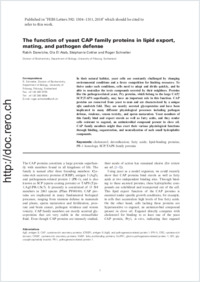The function of yeast CAP family proteins in lipid export, mating, and pathogen defense
- Darwiche, Rabih Division of Biochemistry, Department of Biology, University of Fribourg, Switzerland
- Atab, Ola El Division of Biochemistry, Department of Biology, University of Fribourg, Switzerland
- Cottier, Stéphanie Division of Biochemistry, Department of Biology, University of Fribourg, Switzerland
- Schneiter, Roger Division of Biochemistry, Department of Biology, University of Fribourg, Switzerland
-
2018
Published in:
- FEBS Letters. - 2018, vol. 592, no. 8, p. 1304–1311
English
In their natural habitat, yeast cells are constantly challenged by changing environmental conditions and a fierce competition for limiting resources. To thrive under such conditions, cells need to adapt and divide quickly, and be able to neutralize the toxic compounds secreted by their neighbors. Proteins like the pathogen‐related yeast, Pry proteins, which belong to the large CAP/SCP/TAPS superfamily, may have an important role in this function. CAP proteins are conserved from yeast to man and are characterized by a unique αβα sandwich fold. They are mostly secreted glycoproteins and have been implicated in many different physiological processes including pathogen defense, virulence, venom toxicity, and sperm maturation. Yeast members of this family bind and export sterols as well as fatty acids, and they render cells resistant to eugenol, an antimicrobial compound present in clove oil. CAP family members might thus exert their various physiological functions through binding, sequestration, and neutralization of such small hydrophobic compounds.
- Faculty
- Faculté des sciences et de médecine
- Department
- Département de Biologie
- Language
-
- English
- Classification
- Biological sciences
- License
-
License undefined
- Identifiers
-
- RERO DOC 309427
- DOI 10.1002/1873-3468.12909
- Persistent URL
- https://folia.unifr.ch/unifr/documents/306918
Statistics
Document views: 94
File downloads:
- pdf: 160
